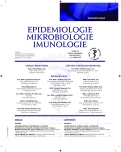Epidemiological investigation in five dental offices of the Clinic of Dentistry, Faculty of Medicine, Palacký University, Olomouc and of the Olomouc University Hospital
Authors:
E. Sedlatá Jurásková 1; I. Matoušková 2
Authors place of work:
Klinika zubního lékařství LF UP Olomouc a FN Olomouc, Ortodontické oddělení
1; Ústav preventivního lékařství LF UP v Olomouci
2
Published in the journal:
Epidemiol. Mikrobiol. Imunol. 63, 2014, č. 1, s. 56-60
Category:
Souhrnná sdělení, původní práce, kazuistiky
Summary
The aim of this epidemiological investigation was to determine microbial contamination of surfaces, medical devices, and equipment in five outpatient dental offices of the Clinic of Dentistry, Faculty of Medicine, Palacký University, Olomouc and of the Olomouc University Hospital. The epidemiological investigation was carried out as a one-time detection of microbial contamination from selected at risk sites on the dental unit with chair and in its immediate surroundings that had been sampled before the staff and patients arrived in the morning. The rates of culture-negative results ranged from 6.0 % in the children's dental office to 17.3 % in the dental prosthetics office. No statistically significant difference in these rates was found between different types of dental offices. The most commonly identified microorganisms were coagulase-negative staphylococci and Bacillus sp. Pseudomonas aeruginosa often reported to be the cause of hospital infection was isolated from the spittoon drain in most of the cases. No methicillin-resistant Staphylococcus aureus was cultured from the swabs. We believe that the microorganisms isolated from the at risk sites are indoor airborne pathogens initially present in aerosols and then deposited on surfaces during the time after working hours.
Keywords:
dental office – bioaersol – contamination of surfaces – infectious agent
Zdroje
1. Luksamijarulkul P, Panya N, Sujirarat D, Thaweboon S. Microbial air quality and standard precaution practice in a hospital dental clinic. J Med Assoc Thai, 2009;92(Suppl 7): 148–155.
2. Rautemaa R, Nordberg A, Wuolijoki-Saaristo K, Meurman JH. Bacterial aerosol in dental practice – a potential hospital infection problem? J Hosp Infect, 2006;64:76–81.
3. Harrel SK, Molinari J. Aerosol and splatter in dentistry: A brief review of the literatura and infection control implications. J Am Dent Assoc, 2004;135:429–437.
4. Bennett AM, Fulford MR, Walker JT, Bradshaw DJ et al. Microbial aerosol in general dental practice. Br Dent J, 2000;23, 189(12):664–667.
5. Centers for Disease Control. Recommended infection-control practices for dentistry. Morb Mortal Wkly Rep, 1986;35:237–242.
6. Centers for Disease Control. Guidelines for infection-control in dental health-care settings 2003. Morb Mortal Wkly Rep, 2003;52(RR-17):1–76.
7. Vyhláška č. 306/2012 Sb., o podmínkách předcházení vzniku a šíření infekčních onemocnění a hygienických požadavcích na provoz zdravotnických zařízení a ústavů sociální péče.
8. Aprea L, Cannova L, Firenze A, Bivona MS, et al. Can technical, functional and structural characteristics of dental units predict Leionella pneumophila and Pseudomonas aeruginosa contamination? J Oral Sci, 2010;52(4):641–646.
9. La Rosa G, Fratini M, Libera D, Libera SD, Iaconelli M et al. Viral infections acquired indoors through airborne, droplet or contact transmission. Ann Ist Super Sanita, 2013;49(2):124–132.
10. Weber DJ, Anderson D, Rutala WA. The role of the surface environment in healthcare-associated infections. Curr Opin Infect Dis, 2013;26(4):338–344.
11. Hübner NO, Handrup S, Meyer G, Kramer A. Impact of the „Guidelines for infection prevention in dentistry“ (2006) by the Commission of Hospital Hygiene and Infection Prevention at the Robert Koch-Institute (KRINKO) on hygiene management in dental practices – analysis of a survey from 2009. GMS Krankenhhyg Interdiszip, 2012;7(1):1–6.
12. Klevens RM, Gorwitz RJ, Collins AS. Methicillin-resistant Staphylococcus aureus: a primer for dentists. J Am Dent Assoc, 2008;139(10):1328-37.
13. Otter JA, Yezli S, French GL. The role played by contaminated surface in the transmission of nosocomial pathogens. Infect Control Hosp Epidemiol, 2011;32(7):687–699.
14. Decraene V, Ready D, Pratten J, Wilson M. Air-borne microbial contamination of surface in a UK dental clinic. J Gen Appl Microbiol, 2008;54:195–203.
15. Krogulski A, Szczotko M. Microbiological quality of hospital indoor air. Determinant factors for microbial concentration in air of operating theatres. Rocz Panstw Zakl Hig, 2011;62(1):109–113.
16. Milton DK, Feldman HA, Neuberg DS, Bruckner RJ, et al. Enviromental endotoxin measurement: the Kinetic Limulus Assay with Resistant-parallel-line Estimation. Environ Res, 1992;57:212–230.
17. Möller W, Heimbeck I, Hofer TPJ, Saba GK, et al. Differential Inflammatory Response to Inhaled Lipopolysaccharide Targeted Either to the Airways or the Alveoli in Man. PLoS ONE, 2012;7(4) , e33505. doi:10.1371/journal.pone.0033505.
18. Bonetta S, Bonetta S, Mosso S, Sampo S, et al. Assessment of microbiological indoor air quality in an Italian office building equipped with an HAVC system. Environ Monit Assess, 2010;161:473–483.
19. Boyce JM, Havill NL, Moore BA. Terminal decontamination of patient rooms using an automated mobile UV light unit. Infect Control Hosp Epidemiol, 2011;32(8):737–742.
20. Rutala WA, Gergen MF, Tande BM, Weber DJ. Rapid hospital room decontamination using ultraviolet (UV) light with a nanostructured UV- reflective wall coating. Infect Control Hosp Epidemiol, 2013;34(5):527–529.
Štítky
Hygiena a epidemiologie Infekční lékařství MikrobiologieČlánek vyšel v časopise
Epidemiologie, mikrobiologie, imunologie

2014 Číslo 1
- Diagnostický algoritmus při podezření na syndrom periodické horečky
- Stillova choroba: vzácné a závažné systémové onemocnění
- Choroby jater v ordinaci praktického lékaře – význam jaterních testů
- Jak souvisí postcovidový syndrom s poškozením mozku?
Nejčtenější v tomto čísle
- Bakterie komplexu Burkholderia cepacia – epidemiologie a diagnostika infekcí u pacientů s cystickou fibrózou
- Legionelové infekce – opomíjený problém
- Epidemiologické šetření v pěti ambulancích Kliniky zubního lékařství LF UP v Olomouci a FN Olomouc
- Klinické a epidemiologické charakteristiky pacientů hospitalizovaných pro těžký průběh chřipky v sezoně 2012–2013
